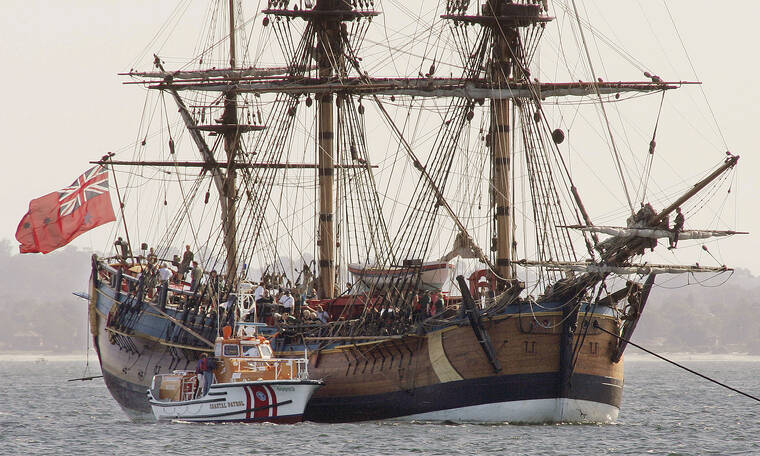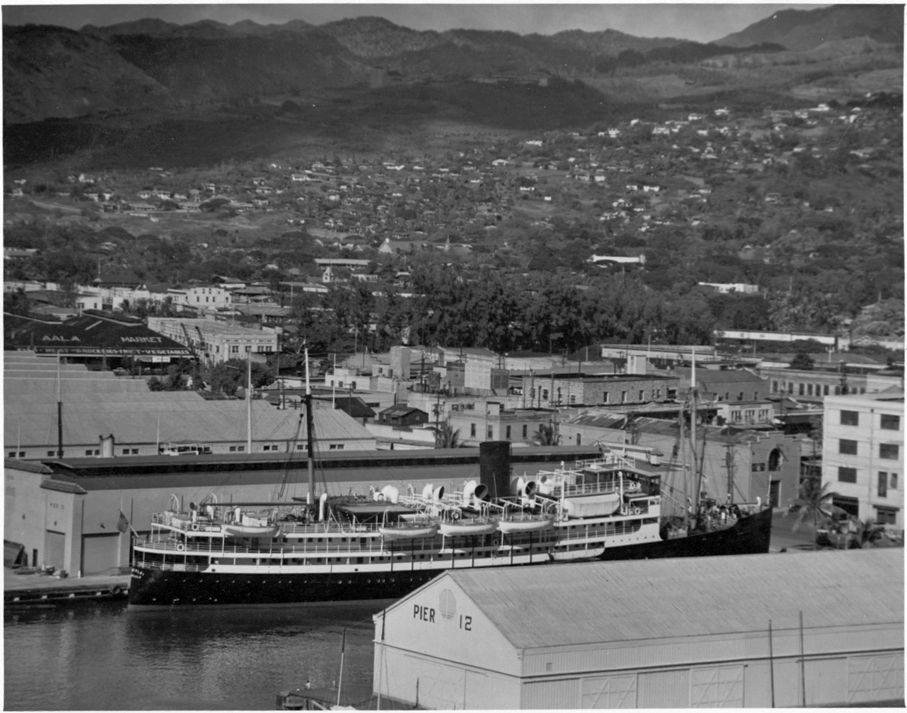A ship now simply known as RI 2394 lies wrecked on the muddy seabed of Newport Harbor. It had been sunk by the British military in an American harbor.
Its location was forgotten for over two centuries until Australian maritime archaeologists worked with a team in Newport Harbor, Rhode Island, to hunt for clues that confirmed its identity.
Then, … “it is with great pride that after a 22-year program of archival and archaeological fieldwork that, based on a preponderance of evidence approach, I have concluded that an archaeological site known as RI 2394, located in Newport Harbor, Rhode Island, USA, comprises the shipwreck of HM Bark Endeavour.” (Kevin Sumpton, Australian National Maritime Museum)
However, the Rhode Island Marine Archaeology Project, reportedly the lead organization for the study in Newport harbor, says “the report that the Endeavour has been identified is premature.”
Let’s look back …
In the late-1700s, the small seaside village of Whitby was known as a ‘nursery’ for mariners, where expert shipbuilders and the most competent seafarers completed their apprenticeships. This center for commercial trade bred colliers – sturdy ships capable of carrying heavy loads, including coal, across the Baltic Sea and beyond.
They were steady workhorses that could be relied upon. Their solid, flat-floored hulls were adept in navigating shallow harbors and estuaries.
Earl of Pembroke was one such vessel, built by Thomas Fishburn for Thomas Milner in 1764. The ship was used as a coal carrier.
One of its rare and distinguishing features was a ‘deadwood’ or ‘rider’ keelson that ran along the inside bottom of the hull. This reinforcing centerline timber prevented the vessel from breaking its back when loading or unloading cargo in shallow tidal waters.
A March 27, 1768 letter from The Yard Officers, Deptford to The Royal Navy Board stated, “We have surveyed and measured the undermentioned ships recommended to your Honours to proceed on Foreign Service and send you an account of their quantities, condition, age and dimensions …”
“The Earl of Pembroke, Mr Thos. Milner, ownes was built at Whitby, her age three years nine months, square stern bark, single bottom, full built and comes nearest to the tonnage mentioned in your warrant and not so old by fourteen months, is a promising ship for sailing of this kind and fit to stow provisions and stores as may be put on board her.”
A subsequent letter from The Royal Navy to the Secretary of the Admiralty on March 29, 1768 stated, “We desire that you will inform their Lordships that we have purchased a catbuilt bark, in burthen 368 tons, and of the age of three years and nine months, for conveying such persons as shall be thought proper to the southward …”
“… for making observations of the passage of the planet Venus over the disc of the sun, and pray to be favoured with their Lordships’ directions for fitting her for this service accordingly … and that we may also receive Their commands by what name she shall be registered on the list of the Navy.”
An April 5, April 1768 response stated, “We do hereby desire and direct you to cause the said vessel to be sheathed, filled, and fitted in all respects proper for that service, and to report to us when she will be ready to receive men. And you are to cause the said vessel to be registered on the list of the Royal Navy as a bark by the name of the Endeavour”.
Captain James Cook’s first Pacific voyage (1768-1771) was aboard the Endeavour and began on May 27, 1768. It had three aims; establish an observatory at Tahiti to record the transit of Venus (when Venus passes between the earth and the sun – June 3, 1769;) record natural history, led by 25-year-old Joseph Banks; and continue the search for the Great South Land.
When Captain Cook set sail on the first of three voyages to the South Seas, he carried with him secret orders from the British Admiralty to seek ‘a Continent or Land of great extent’ and to take possession of that country ‘in the Name of the King of Great Britain’.
While each of the three journeys made by Captain Cook into the Pacific had its own aim and yielded its own discoveries, it was this confidential agenda that would transform the way Europeans viewed the Pacific Ocean and its lands. (State Library, New South Wales)
Endeavour voyaged to the South Pacific, mainly to record the transit of Venus in Tahiti in 1769. After that, the ship sailed around the South Pacific searching for the “Great Southern Land.” (Wall Street Journal)
After heading west from England, rounding Cape Horn beneath South America and crossing the Pacific, Cook landed the Endeavour in Australia’s Botany Bay on April 29, 1770. To the British, Cook went down in history as the man who ‘discovered’ Australia – despite Aboriginal Australians having lived there for 50,000 years and the Dutch traversing its shores for centuries. (Ward)
When Endeavour sailed around the coast of Australia, on June 11, 1770, she became stuck in a reef, now known as Endeavour Reef (part of the Great Barrier Reef). Cook ordered that all extra weight and unnecessary equipment be removed from the ship to help her float.
The reef had created a hole in the hull which, if removed from the reef, would cause the ship the flood. After several attempts, Cook and his crew successfully freed Endeavour but she was in a dire condition. She sailed to Batavia, part of the Dutch East Indies, to properly repair her before the voyage home.
Captain Cook’s charting of Australia’s east coast paved the way for the establishment of a penal colony. In 1788, British settlers landed in what is now downtown Sydney.
At the time Captain Cook was sailing in the Pacific and bumped into Hawai’i (January 18, 1778) recall that back in the Atlantic, the American Revolutionary War was still ongoing with the Americans (with support from the French) fighting the British.
After returning to Britain in 1771, the Endeavour was sent to Woolwich to be refitted to be used as a naval transport and store ship, frequently operating between Britain and the Falklands. In 1775 she was sold out of the navy to a shipping company Mather & Co. She was refitted and renamed Lord Sandwich.
Lord Sandwich was also contracted by the British navy to transport soldiers in 1776 to fight against the American colonists who sought to break free from British control.
In 1776, Lord Sandwich was stationed in New York during the Battle of Long Island that led to the British capture of New York. In August 1778, the British scuttled the Lord Sandwich and four other vessels at Newport Harbor to try to create a blockade to stop a fleet of French warships that had sailed in to support the American forces. (VOA News)
Cook’s second Pacific voyage (1772-1775) aboard Resolution and Adventure aimed to establish whether there was an inhabited southern continent, and make astronomical observations.
Cook’s third and final voyage (1776-1779) of discovery was an attempt to locate a North-West Passage, an ice-free sea route which linked the Atlantic to the Pacific Ocean. Cook commanded the Resolution while Charles Clerke commanded Discovery. (State Library, New South Wales)
Cook’s crew first sighted the Hawaiian Islands in the dawn hours of January 18, 1778. His two ships, the HMS Resolution and the HMS Discovery, were kept at bay by the weather until the next day when they approached Kauai’s southeast coast.
On the afternoon of January 19, native Hawaiians in canoes paddled out to meet Cook’s ships, and so began Hawai’i’s contact with Westerners. The first Hawaiians to greet Cook were from the Kōloa south shore.
The Hawaiians traded fish and sweet potatoes for pieces of iron and brass that were lowered down from Cook’s ships to the Hawaiians’ canoes.
The Island “were named by Captain Cook the Sandwich Islands, in honour of the Earl of Sandwich, under whose administration he had enriched geography with so many splendid and important discoveries.” (Captain King’s Journal; Kerr)
Hawaiian lives changed with sudden and lasting impact, when western contact changed the course of history for Hawai’i.
At the time of Cook’s arrival (1778-1779), the Hawaiian Islands were divided into four kingdoms: (1) the island of Hawaiʻi under the rule of Kalaniʻōpuʻu, who also had possession of the Hāna district of east Maui; (2) Maui (except the Hāna district,) Molokai, Lanai and Kahoʻolawe, ruled by Kahekili; (3) Oʻahu, under the rule of Kahahana; and at (4) Kauai and Niʻihau, Kamakahelei was ruler.
Throughout their stay, the ships were supplied with fresh provisions which were paid for mainly with iron, much of it in the form of long iron daggers made by the ships’ blacksmiths on the pattern of the wooden pāhoa used by the Hawaiians.
After a month’s stay, Cook got under sail again to resume his exploration of the Northern Pacific. Shortly after leaving Hawaiʻi Island, the foremast of the Resolution broke. They returned to Kealakekua. On February 14, 1779, Cook was killed. (Information here is from Australian National Maritime Museum, Ward, RIMAP, MuSEAum).)










































